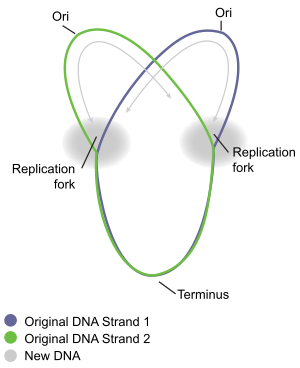Circular chromosome
The E. coli origin of replication, called oriC consists of DNA sequences that are recognised by the DnaA protein, which is highly conserved amongst different bacterial species.DnaA binding to the origin initiates the regulated recruitment of other enzymes and proteins that will eventually lead to the establishment of two complete replisomes for bidirectional replication.The methylation of adenines is important as it alters the conformation of DNA to promote strand separation,[6] and it appears that this region of oriC has a natural tendency to unwind.[8] After DnaB translocates to the apex of each replication fork, the helicase both unwinds the parental DNA and interacts momentarily with primase.He then isolated the chromosomes by lysing the cells gently and placed them on an electron micrograph (EM) grid which he exposed to X-ray film for two months.The regions of DNA undergoing replication during the experiment were then visualized by using autoradiography and examining the developed film microscopically.Deoxynucleotides are then added to this primer by a single DNA polymerase III dimer, in an integrated complex with DnaB helicase.[15] The encountered DNA damages are ordinarily processed by recombinational repair enzymes to allow continued replication fork progression.[15] Termination is the process of fusion of replication forks and disassembly of the replisomes to yield two separate and complete DNA molecules.The arrangement of the Ter sites forms two opposed groups that forces the two forks to meet each other within the region they span.In an experiment by Zechiedrich, Khodursky and Cozzarelli in 1997, it was found that topoisomerase IV is the only important decatenase of DNA replication intermediates in bacteria.This suggests that Topoisomerase IV is the primary protein for decatenation of interlinked chromosomes in vivo, with DNA gyrase playing a minor role.



bacteriaarchaealinear chromosomeeukaryotestelomeresreplicate the DNAcell divisionEscherichia coliBacillus subtilisenzymesreplichorereplisomeDNA helicasereplication forkDNA polymeraseorigin of replicationDNA sequencesconservedbacterialproteinshistonedouble-stranded DNADNA unwinding elementDNA adenine methylasemethylationadenineshelicaseprimasebinding proteinsre-annealingDNA gyraseJohn Cairnstheta structureradioactively labeledthymidinenucleosideelectron micrographradioactive isotopesautoradiographyDNA polymerase III holoenzymedimericmonomericdimerizationprocessivityleading strandOkazaki fragmentlagging strandRNA primerDeoxynucleotidesdeoxyribonucleotidesDNA polymerase IexonucleaseDNA ligaseDNA damagerecombinationalDNA moleculesDNA unwinding activitycrystal structurecatenanestopoisomerasessupercoilsprokaryotesZechiedrichin vivoBrucellaParacoccus denitrificansVibrioAlphaproteobacteriaBrucella melitensischromidcodon usageParacoccusCatenaneMöbius stripNucleoidPlasmidRibbon theoryRolling circle replicationTopoisomeraseTheta type replicationCitizendiumBibcodeSelf-replicatingCellular lifeEukaryotaAnimaliaPlantaeProtistaIncertae sedisParakaryonBiological dark matterGiant virusdsRNA virusssRNA-RT virusdsDNA-RT virusSubviralagentsViroidPospiviroidaeAvsunviroidaeHelper-virusdependentSatelliteVirophageVirusoidDefective interfering particleMammalian prionFungal prionNucleic acidMobile geneticelementsMobilomeHorizontal gene transferGenomic islandTransposable elementClass I or retrotransposonClass II or DNA transposonFertilityResistanceVirulenceCosmidFosmidPhagemidGroup I intronGroup II intronRetrozymeDNA replicationRNA replicationChromosome